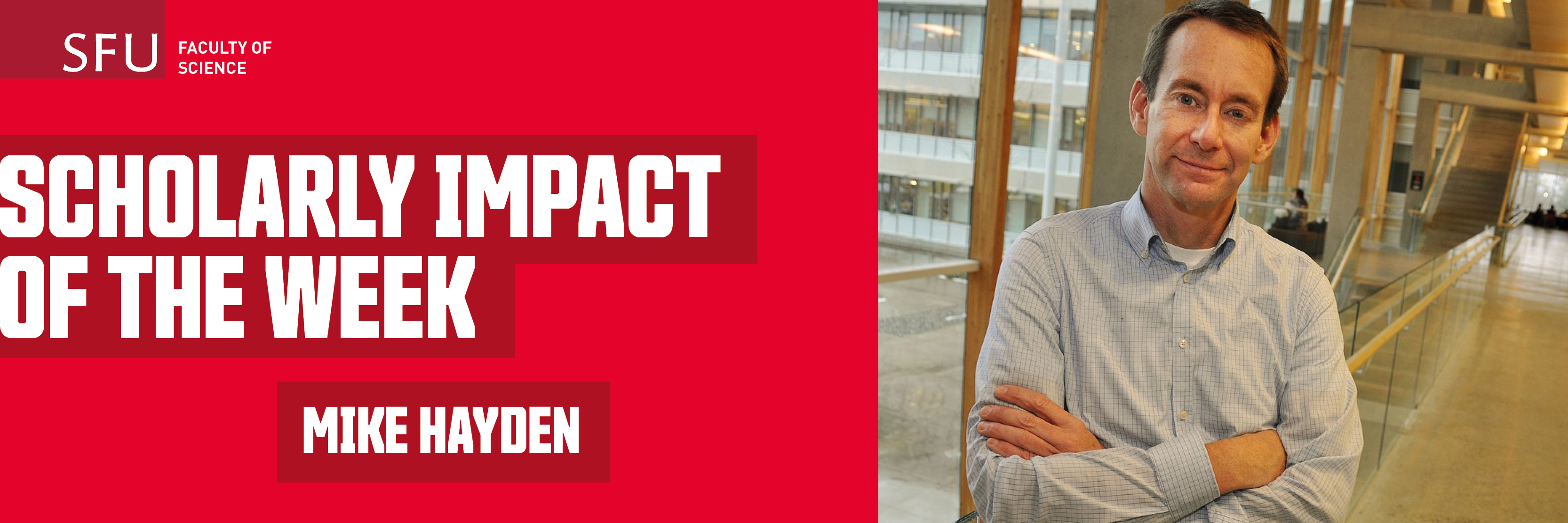
SFU Distinguished Professor Mike Hayden is a prominent investigator in the field of antimatter physics. For the past decade and a half, he has been a senior researcher with the ALPHA Project, a collaboration of physicists from eight countries dedicated to studying the properties of antihydrogen, the antimatter counterpart of the ordinary hydrogen atom.
A challenge faced by researchers in this field is that matter and antimatter annihilate whenever they come into contact. There is no ordinary container into which antihydrogen can simply be put in order to study it. Hayden and his ALPHA collaborators get around this by creating and studying antimatter in elaborate magnetic traps with no physical walls.
Their latest innovation, Laser cooling of antihydrogen atoms, was featured on the cover of Nature magazine and flagged as a top 10 finalist for Breakthrough of the Year by the editors of Physics World. It involves slowing trapped antimatter atoms to unprecedentedly low velocities by bathing them in a beam of ultraviolet light. This in turn makes it possible to perform much more precise measurements of their properties.
We met with Mike Hayden to discuss his research.
This research sounds intriguing, but it also sounds difficult. What is its purpose? Why is it so important to understand antimatter?
Matter and antimatter are intertwined. We think they were created in equal parts during the Big Bang. Ever since, whenever they meet, they annihilate one another. Despite this pairing, the universe we live in today is almost entirely devoid of antimatter. Somehow, over time matter seems to have won out over antimatter.
The problem is that we really have no idea how this came to be. The only thing we know for sure is that our best theory of fundamental particles—something we call the Standard Model—must be incomplete.
Our goal is to probe the antihydrogen atom in every way possible, looking for subtle ways in which it might be different from hydrogen. If there is a difference, it might give us a clue. It would almost certainly have profound consequences for our understanding of nature.
It must be challenging to isolate these elusive atoms. How do you do it?
Unfortunately, we do not have a natural source of antihydrogen atoms we can tap. We must make them from scratch, by combining antiprotons and positrons. These are the antimatter counterparts of ordinary protons and electrons.
It is relatively easy to make antihydrogen. The hard part is to trap it. Most of the atoms we make have far too much energy to be caught and held in our magnetic bottle. They just fly right through the magnetic fields, collide with the walls of our apparatus, and annihilate. It took us many years of work to figure out how to make atoms that are cold and slow enough to be caught.
This research is the latest in a series of breakthroughs by ALPHA. At last count your team had published 14 papers in Nature journals alone. Now that you can cool these atoms with lasers, what will you do next?
Cooling antihydrogen is a game changer. Almost every experiment we have performed can now be improved, a lot.
Many of our experiments involve spectroscopy. We interrogate antihydrogen with lasers and microwave sources that are finely tuned to very specific frequencies, and cause the atoms to jump from one state to another. These resonances are like fingerprints. They identify the atom. And, when the atoms are cold, we expect to resolve them to much higher precision.
But, that is only part of what we are up to at the moment. Over the last several years we have built a new apparatus that will make it possible for us to ask entirely new questions about antihydrogen. The first one is simple but fascinating. What happens when you drop an antimatter atom? Does it fall down, toward Earth? Or does it fall up?
Collaboration seems to be an essential part of this research. What is it like to work on a project like ALPHA?
You are absolutely right. The scale and complexity of these experiments are far beyond what any of us could do as individuals at our home institutions. ALPHA’s successes depend critically on teamwork, the breadth of expertise we are able to draw upon, and of course many long days and nights spent in the lab.
I spend a good deal of my time working with microwaves and other electromagnetic fields, but I regularly interact with ALPHA colleagues who focus instead on lasers, plasmas, particle detectors and many other aspects of the experiment.
All of this makes for an invigorating work environment and an exciting place for graduate students to interact with scientists from around the world.
For more, read the CERN Press Release, explore the ALPHA website or watch videos showing the construction of an antihydrogen trapping apparatus.
SFU's Scholarly Impact of the Week series does not reflect the opinions or viewpoints of the university, but those of the scholars. The timing of articles in the series is chosen weeks or months in advance, based on a published set of criteria. Any correspondence with university or world events at the time of publication is purely coincidental.
For more information, please see SFU's Code of Faculty Ethics and Responsibilities and the statement on academic freedom.